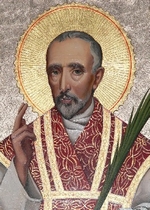Thomas Aufield, also called Thomas Alfield, was an English Roman Catholic martyr.

Edmund Arrowsmith, SJ was one of the Forty Martyrs of England and Wales of the Catholic Church. The main source of information on Arrowsmith is a contemporary account written by an eyewitness and published a short time after his death. This document, conforming to the ancient style of the "Acts of martyrs" includes the story of the execution of another 17th-century recusant martyr, Richard Herst.
Robert Johnson, a Shropshire native, was a Catholic priest and martyr during the reign of Elizabeth I.
John Roberts was a Welsh Benedictine monk and priest, and was the first Prior of St. Gregory's, Douai, France. Returning to England as a missionary priest during the period of recusancy, he was martyred at Tyburn. He is venerated as a saint by the Roman Catholic church.
John Adams was an English Catholic priest and martyr.
John Lowe (1553–1586) was an English Catholic priest and martyr.
John Nelson was an English Jesuit martyr who was executed during the reign of Elizabeth I.

James Duckett was an English Catholic layman and martyr, executed at Tyburn for printing Catholic devotionals.
John Shert was an English Catholic priest and martyr, who was executed during the reign of Elizabeth I.

Luke Kirby was an English Catholic priest and martyr from the North of England, executed during the reign of Elizabeth I. He was is one of the Forty Martyrs of England and Wales.
The Douai Martyrs is a name applied by the Catholic Church to 158 Catholic priests trained in the English College at Douai, France, who were executed by the English state between 1577 and 1680.
Richard Leigh was an English Roman Catholic martyr born in Cambridge, the scion of Cheshire gentry, squires of the West Hall, High Legh since the 11th century.

Henry Heath (1599–1643), religious name Paul of St. Magdalene, was an English priest of the Order of Friars Minor and a Roman Catholic martyr.
John WoodcockO.F.M. (1603–1646) was a Franciscan priest from Lancashire executed in August 1646 under the 1585 "Act against Jesuits, Seminary priests and other such like disobedient persons" for being a priest and present in the realm.
Robert Nutter was an English Catholic priest, Dominican friar and martyr. He was beatified in 1987.

George Haydock was an English Roman Catholic priest. He is a Catholic martyr, beatified in 1987. He is not to be confused with his relative, also a priest, George Leo Haydock (1774–1849).
Edward Stransham was an English Roman Catholic priest. He is a Catholic martyr, beatified in 1929.
Richard Sergeant (executed at Tyburn, 20 April 1586) was an English Roman Catholic priest. He is a Catholic martyr, beatified in 1987.
William Dean or Deane was an English Roman Catholic priest. He is one of the Catholic martyrs, beatified in 1929.
Nicholas Woodfen born Nicholas Wheeler, also known as Nicholas Devereux, was an English Roman Catholic priest who was hanged, drawn and quartered at Tyburn, London on 21 January 1586. He is considered a Catholic martyr and one of the Eighty-five martyrs of England and Wales who were executed between 1584 and 1679. He was beatified on 22 November 1987 by Pope John Paul II.






